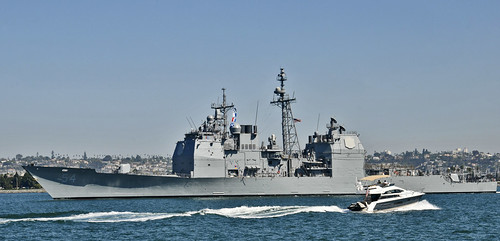By Mass Communication Specialist 3rd Class Ricardo R.
Guzman, USS Antietam Public Affairs
PHILLIPPINE SEA (NNS) -- The Ticonderoga-class
guided-missile cruiser USS Antietam (CG 54) conducted its first
replenishment-at-sea (RAS) of its patrol, May 25.
The mighty Antietam's deck department was at the heart of
the evolution and was responsible for safely receiving 30 pallets of supplies
via vertical replenishment (VERTREP) and approximately 200,000 gallons of fuel
via connected replenishment.
"We're very proficient at every job we do here,"
said Boatswain's Mate 1st Class Eric Viertel, Antietam's deck department
leading petty officer and flight deck officer. "Deck department on a small
ship has more responsibilities than it does on a carrier. We're not only
responsible for deck duties, we're responsible for air department duties as
well."
Antietam began the RAS by approaching the Military Sealift
Command fleet replenishment oiler USNS Rappahannock (T-AO 204) to commence its
fueling-at-sea.
"The sea state, wind and weather were just right for
this evolution," said Viertel. "Those factors can definitely hinder
the RAS. They can cause the ships to pull in too close or pull apart. We have
two ships that should stay between 180 to 200 feet apart, so we need to stay on
course the entire time."
At the helm, was master helmsman-in-training Boatswain's
Mate Seaman Rebecca Brook, from Antietam's deck department. This marked the
first time Brook had ever maneuvered and steered the ship during a RAS since the
beginning of her helmsman training in 2012.
"I was nervous at first," said Brook. "Once
we were alongside, I felt confident in steering. I had never been so close
alongside another ship before. So many things can go wrong if you don't pay
attention so, it's important to listen to the bridge team and stay on
course."
Viertel manned the aft fueling station and led deck
department Sailors in heaving lines, attaching the fueling probe to the ship
and conducting the emergency breakaway drill once the ship was done fueling.
"We finished pumping 200,000 gallons of fuel in about
two hours," said Viertel. "It was very fast. Once that was done, we
had to clean everything up as soon as we could and go up to the flight deck for
the VERTREP."
Both Viertel and Brook made their way over to the hangar bay
to prepare for the VERTREP as both ships steamed further apart from each other.
"Deck [department] jumps from one evolution to the next
on a cruiser," said Brook. "We learn how to do everything here.
That's the great thing about our department, we're always on our toes and we're
part of almost every evolution."
MH-60S Sea Hawk helicopters from the "Island
Knights" of Helicopter Sea Combat Squadron (HSC) 25 were soon delivering
supplies from the Military Sealift Command dry cargo and ammunition ship USNS
Washington Chambers (T-AKE 11) onto Antietam's flight deck.
"I always feel an adrenaline rush when I'm on the
flight deck and there's a helicopter over head," said Brook. "I think
it's fun and it's an awesome experience to go under the [helicopter] and hook
supplies under it or use chock and chains to secure it to the deck."
"It's a little nerve-racking," said Veirtel.
"Being the flight deck officer, you have to keep your head on a swivel and
constantly watch out for everyone. If something goes wrong, it can mean
dropping food, mail falling overboard, parts breaking and even personnel
getting injured or worse. That's why it's important to watch out for every
little thing that goes on."
As the VERTREP comes to a close, the ship continues its
normal operations within its forward-deployed area of responsibilities. Veirtel
and Brook end the day conducting routine flight quarters.
"It's a normal day for us," said Brook. "In
the end, we learn everything about the ship because we're all highly involved
in the day-to-day activities. We do a little more than everyone else and I
think our knowledge makes things run smoothly."
Antietam is on patrol in the U.S. 7th Fleet area of
operations supporting security and stability in the Indo-Asia-Pacific region.








No comments:
Post a Comment